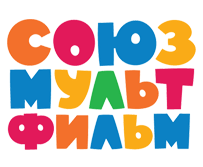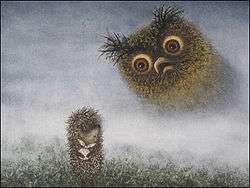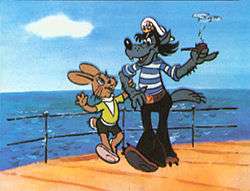Soyuzmultfilm
 | |
| Corporation | |
| Industry | Animated motion pictures |
| Founded | 10 June 1936 |
| Headquarters |
Dolgorukovskaya St. 23a, Moscow, Russia 103006 (film fund: same address, postal code: 127006) |
Key people |
Nikolai Makovsky (creative director)[1] |
| Products |
Animated motion pictures Television programs |
| Owner | Ministry for Culture of Russia |
Number of employees |
Of creative studio: 123 as of 14 April 2007[3] (it is unclear whether this number includes contractors) |
| Website |
www |
Soyuzmultfilm (Russian: Союзмультфильм; IPA: [səjʉsmʊlʲtˈfʲilʲm], Union Cartoon) is a Russian animation studio based in Moscow. Over the years it has gained international attention and respect, garnering numerous awards both at home and abroad. Noted for a great variety of style, it is regarded as the most influential animation studio of the former Soviet Union. The studio has produced 1530 films during its existence.[4]
It is currently divided into two studios: "Creative union of the "Film studio "Soyuzmultfilm" («Творческо-производственное объединение «Киностудия «Союзмультфильм») and the Soyuzmultfilm Film Fund («Фильмофонд Киностудии «Союзмультфильм»).
History during the Soviet era

The Studio was founded on 10 June 1936 under the name Soyuzdetmultfilm (Союздетмультфильм – abbr. from Union Children's Animations). The name was changed to Soyuzmultfilm on 20 August 1937. Initially comprising only a few scattered workshops, Soyuzmultfilm grew quickly, soon becoming the Soviet Union's premier animation studio. The studio produced exclusively traditional animation until 1954, when a "puppet division" was founded and the first stop motion-animated film released. The puppet division would later also make cutout-animated films.
During the Soviet era, the studio employed a maximum of over 700[3] skilled labourers and released an average of 20 films each year (the highest number was 47, in 1973). The studio was one of the most ethnically-integrated cultural industries in the Soviet Union.[5]
Over the next five decades, many Soyuzmultfilms contained characters who would eventually become an integral part of Soviet culture, such as Winnie-the-Pooh (Винни-Пух), Crocodile Gena (Крокодил Гена), Film, Film, Film (Фильм, фильм, фильм), Karlsson-on-the-Roof (Карлсон, который живёт на крыше), The Musicians of Bremen (Бременские музыканты), Three from Prostokvashino (Трое из Простоквашино), Nu, pogodi! (Ну, погоди!), Hedgehog in the Fog (Ёжик в тумане), and The Mystery of the Third Planet (Тайна третьей планеты).
The variety of animation styles and the unprecedented degree of artistic freedom given to its many animators made Soyuzmultfilm perhaps the most diverse of the world's major animation studios. Soyuzmultfilm's creativity was fueled in part by the socialist economy of the Soviet Union, which obviated the goal of profitability. Because animators were paid by the Academy of Film regardless of how well or how poorly their products sold (though they were not, in fact, "sold"), they were free to pursue their artistic vision without giving a thought to finances.
Soyuzmultfilm's decline

The collapse of the Soviet Union brought to a close the golden era of Soyuzmultfilm. New economic realities made it impossible for the government to support the studio any longer. In 1989, Soyuzmultfilm was made into a leased enterprise (expiring after 10 years) and forced into the capitalist marketplace.
Although the studio survived, it shrank dramatically, losing nearly 90% of its staff and releasing only a few films. One early misfortune happened when the Russian courts transferred the studio's puppet division building (in a legal decision involving many other buildings) to the Russian Orthodox Church. Before the animators could react to this turn of events, an Orthodox Cossack squadron, accompanied by religious locals, broke into the building with swords unsheathed for the purpose of exorcism and began throwing out the "satanic puppets animated with the blood of Christian babies".[6] No studio employees were allowed to come in and salvage any item, despite the presence of much expensive equipment and a whole library of puppets.[7]
The main reason for the collapse, however, was the studio's deliberate dismantling by the new top management and the illegal selling off of its assets for personal gain (see:[8] – in Russian). In 1992–1993, Sergei Skulyabin was elected president.
Films by Jove controversy
In 1992, the studio signed a deal with the American company Films by Jove, owned by Russian immigrant actor Oleg Vidov and his American wife Joan Borsten.[9] It was the first international offer that the studio had received. The deal stipulated that Films by Jove would be granted the rights to 547 of the most popular classic studio films for a period of 10 years in all territories except the CIS; as part of the return, Soyuzmultfilm would receive 37% of the net profits. Films by Jove restored many of the films and released many of them on television, video and DVD in the United States and Europe, albeit usually with dubbed voices and changed music.

According to current director Akop Kirakosyan, the original deal seemed promising at the time but turned out to be "deadly" for the studio. The expected payouts never materialized because Films by Jove never posted any net profits; all of the money officially went to things such as new soundtracks, lawsuits and copy protection measures.[3]
Whether either deal was legal was debated in court, with the Soyuzmultfilm Film Fund (see section below) claiming that because the company's lease on its possessions would have expired in 1999 (at which time ownership would have automatically reverted to the government if no new lease were signed), Soyuzmultfilm had no authority to issue rights that lasted beyond that timeframe.[10] Joan Borsten presented a different story.[11] In the end, the Russian courts sided with Soyuzmultfilm and the American courts sided with Films by Jove.
U.S. Federal Court found that the Russian government has twice tried to invalidate Judge Trager's August 2001 summary judgment decision in favor of Films By Jove and transfer the copyrights to a library of 1,500 animated films, which Films by Jove licensed from Soyuzmultfilm Studios in 1992 to a new state-owned company. The judge found evidence of "continued actions being taken by the Russian government and judiciary to influence the outcome of this United States litigation with the purpose of depriving plaintiff Films by Jove of its right to distribute the animated films in the United States and elsewhere outside the former Soviet Union." The voulminous and very thorough decision further noted that, "In the case at bar, expropriation of the property of an American company by an act of a foreign sovereign is unquestionably against the public policy of the United States."
On 11 April 2007, Russian businessman Alisher Usmanov announced that he was in the final stages of negotiating a price with Films by Jove to buy back the collection. A source close to Usmanov said that Films by Jove's initial price was $10 million, while Usmanov is willing to pay "several times less", as he considers that the rights already belong to Soyuzmultfilm and that he himself is only buying the physical film prints.[10] In September 2007, the deal was finalized, and Usmanov handed everything over to Russian state children's TV channel Bibigon.[12]
Soyuzmultfilm today

In 1999, Soyuzmultfilm came back under the control of the government. A government edict on August 12, 2003 divided the company into two separate companies. The separation was finalised on March 1, 2004.
The rights of all Soyuzmultfilm films before March 1, 2004 belong to the "Soyuzmultfilm Film Fund", headed by Ernest Rakhimov, and its official mission is restoring and marketing them. The mission of the "Creative union of the "Film studio "Soyuzmultfilm", headed by Akop Kirakosyan, is to create new films (anywhere from 3–7 short films a year) and to eventually privatize itself (currently, 100% of its stock is owned by the Russian Ministry of Culture).
The next year, Soyuzmultfilm created an animated opening title for the children's TV show Ulitsa Sezam.
In August 2013, the studio relocated to Moscow's Design Bureau of Film Equipment, after spending 68 years in their former premises. According to artistic director Michael Aldashin, "Everything must be decided within a year. There are too many technical and bureaucratic problems, but we are clearly moving." Aldashin also cited the limited space in the premises as a factor behind the move.[13]
As of 2013, Soyuzmultfilm is contemplating the production of computed-animated and educational films, as well as video games.[13] Since the early 2000s, the studio has worked on the upcoming feature film Hoffmaniada.[13] Backed by Mikhail Shemyakin and directed by Stanislav Sokolov, it will be based on the tales of E. T. A. Hoffmann. The film will use stop motion animation exclusively and will avoid using computer animation for special effects. The first 20 minutes were screened on November 20, 2006, in Saint Petersburg, and the full film is planned for a 2016 release.[13]
Notable artists
|
Animators & directors
|
|
Actors |
Selected films
- 1942 Fox, Hare and Cock (Лиса, Заяц и Петух)
- 1944 The Stolen Sun (Краденое солнце)
- 1945 The Lost Letter (Пропавшая грамота)
- 1946 Spring Melodies (Весе́нние мело́дии)
- 1947 The Humpbacked Horse (Конёк-Горбуно́к)
- 1947 To You, Moscow (Тебе́, Москва́!)
- 1948 The 7 coloured flower (Цветик-семицветик)
- 1949 Geese-Swans (Гуси-лебеди)
- 1949 Someone Else's Voice (Чужой голос)
- 1949 Wonderful Bell (Чудесный колокольчик)
- 1950 The Tale of the Fisherman and the Goldfish (Сказка о рыбаке и золотой рыбке)
- 1950 When New Year trees are lighted (Когда зажигаются ёлки)
- 1950 Who's first? (Кто первый?)
- 1950 Magic treasure (Волшебный клад)
- 1950 The girl in circus (Девочка в цирке)
- 1950 The little pipe and the small jug (Дедушка и кувшинчик)
- 1950 The yellow stork (Желтый аист)
- 1950 The grandpa and the grandchild (Дедушка и внучек)
- 1950 The sturdy fellow (Крепыш)
- 1950 The fox-builder (Лиса-строитель)
- 1950 The deer and the wolf (Олень и волк)
- 1950 Wonderful mill (Чудо-мельница)
- 1951 Taiga Tale (Таёжная сказка)
- 1951 The Tale of the Dead Tsarevna and the Seven Bogatyrs (Сказка о мёртвой царевне и о семи богатырях)
- 1951 The high hill (Высокая горка)
- 1951 Friends-companions (Друзья-товарищи)
- 1951 Forest travelers (Лесные путешественники)
- 1951 Carefully with fire (Осторожно с огнём)
- 1951 Remember and follow fire safety regulations (Помни и соблюдай правила пожарной безопасности)
- 1951 The brave man's heart (Сердце храбреца)
- 1951 The Night Before Christmas (Ночь перед Рождеством)
- 1952 The Scarlet Flower (А́ленький цвето́чек)
- 1952 The Snow Maiden (Снегу́рочка)
- 1952 Kashtanka (Каштанка)
- 1952 Bring-down-an-oak (Валидуб)
- 1952 The little Ha & Re (Зай и Чик)
- 1952 Sarmiko (Сармико)
- 1953 Flight to the Moon (Полёт на Луну)
- 1953 The Painted Fox (Фарбований лис)
- 1954 Tsarevna the Frog (Царевна лягушка)
- 1954 The Golden Antelope (Золота́я антило́па)
- 1955 The Enchanted Boy (Заколдованный мальчик)
- 1956 A Million in the Bag (Миллион в мешке)
- 1956 The Twelve Months (Двенадцать месяцев)
- 1956 The Ugly Duckling (Гадкий утенок)
- 1956 The Stork (Аист)
- 1956 In a Yaranga Fire Burns (В яранге горит огонь)
- 1956 The Girl in the Jungle (Девочка в джунглях)
- 1956 The Kolobok (Колобок)
- 1956 The Little Ship (Кораблик)
- 1956 The Forest Story (Лесная история)
- 1956 The Little Shego (Маленький Шего)
- 1956 The Heavenly Creation (Небесное создание)
- 1956 The Helping-out Stick (Палка-выручалка)
- 1956 The Little Pie (Пирожок)
- 1956 The Murzilka's Adventures (Приключения Мурзилки)
- 1956 The Tale of the Priest and of His Workman Balda (Сказка о попе и его работнике Балде)
- 1956 The Old Acquaintances (Старые знакомые)
- 1956 The Wonderful Well (Чудесный колодец)
- 1956 The Little Jackal and the Camel (Шакалёнок и верблюд)
- 1957 One in a faraway tsardom (В не́котором ца́рстве)
- 1957 The Snow Queen (Сне́жная короле́ва)
- 1957 In some dining room (В одной столовой)
- 1957 The Verlioka (Верлиока)
- 1957 The Wolf and Seven Kids (Волк и семеро козлят)
- 1957 The Incarnate Dream (Воплощённая мечта)
- 1957 The Child of the Sun (Дитя солнца)
- 1957 The Familiar Pictures (Знакомые картинки)
- 1957 The Fulfillment of Desires (Исполнение желаний)
- 1957 The Our Sun (Наше солнце)
- 1957 Again D (Опять двойка)
- 1957 The Song about Friendship (Песня о дружбе)
- 1957 Why the kitten left (Почему ушел котёнок)
- 1957 Hi to friends! (Привет друзьям!)
- 1957 The Tale of the Snegurochka (Сказка о Снегурочке)
- 1957 Dolls have the word (Слово имеют куклы)
- 1957 The Landing Place (Тихая пристань)
- 1957 The Brave Little Deer (Храбрый оленёнок)
- 1957 The Wonderfuly (Чудесница)
- 1957 To the sixth world's (Шестому всемирному)
- 1958 Beloved Beauty (Краса́ ненагля́дная)
- 1958 Cat's House (Кошкин дом)
- 1958 The Boy from Naples (Мальчик из Неаполя)
- 1959 The Adventures of Buratino (Приключе́ния Бурати́но)
- 1960 The Golden Feather (Золотое перышко)
- 1961 Chipolino (Чиполлино)
- 1962 TALE ABOUT ANOTHER'S PAINTS (Сказка про чужие краски)
- 1962 The Story of a Crime (Исто́рия одного́ преступле́ния)
- 1962 The Wild Swans (Ди́кие ле́беди)
- 1964 Lefty (Левша́)
- 1964 Thumbelina (Дюймовочка)
- 1967 Mowgli (Ма́угли)
- 1967 The Mitten (animation film) (Ва́режка)
- 1968 Little Boy and Karlsson (Малы́ш и Ка́рлсон)
- 1968 The Greatest Friend (Самый большой друг)
- 1968 The Little Mermaid (Русалочка)
- 1969–2006 Nu, pogodi! (Ну, погоди!)
- 1969 Crocodile Gena (Крокодил Гена)
- 1969, released 1986 The Glass Harmonica (Стеклянная гармоника)
- 1969 The Bremen Town Musicians (Бременские музыканты)
- 1969 Winnie-the-Pooh (Винни-Пух)
- 1969 Film, Film, Film (Фильм, фильм, фильм)
- 1969 Umka (Умка)
- 1970 Karlsson Returns (Ка́рлсон верну́лся)
- 1971 Cheburashka (Чебура́шка)
- 1971 Winnie-the-Pooh Goes on a Visit (Ви́нни-Пух идёт в го́сти)
- 1972 Winnie-the-Pooh and the Day of Concern (Ви́нни-Пу́х и день забо́т)
- 1973 Miracle (Чудо)
- 1973 On the Trail of Town Musicians of Bremen (По следа́м бре́менских музыка́нтов)
- 1973 The Heron and the Crane (Ца́пля и жура́вль)
- 1973 The Island (О́стров)
- 1973 The Nutcracker (Щелку́нчик)
- 1974 Prometheus (ПРОМЕТЕЙ)
- 1974 Hare Koska and fontenelle (Заяц Коська и родничок)
- 1974 Shapoklyak (Шапокля́к)
- 1975 Hedgehog in the Fog (Ёжик в тума́не)
- 1976 A Kitten Named Woof (Котёнок по имени Гав)
- 1975 The Box with a Secret (Шкату́лка с секре́том)
- 1976–1991 38 Parrots (38 попуга́ев)
- 1977 Polygon (Полигон)
- 1977 The Last Petal (Последний лепесток)
- 1977–1983 The Smallest Dwarf (Самый маленький гном)
- 1978 Three from Prostokvashino (Тро́е из Простоква́шино)
- 1978 Contact (Конта́кт)
- 1978 Mouse Peak (Мышонок Пик)
- 1978–1985 At the back desk (На за́дней па́рте)
- 1979 Tale of Tales (Ска́зка ска́зок)
- 1980 Vacation in Prostokvashino (Кани́кулы в Простоква́шино)
- 1981 The Mystery of the Third Planet (Та́йна тре́тьей плане́ты)
- 1981 Dog in Boots (Пёс в сапога́х)
- 1982 Once Upon a Dog (Жил-был пёс)
- 1983 The Travels of an Ant (Путеше́ствие муравья́)
- 1983 Cheburashka Goes to School (Чебура́шка идёт в шко́лу)
- 1984 Winter in Prostokvashino (Зима́ в Простоква́шино)
- 1984 The Tale of Tsar Saltan (Ска́зка о царе́ Салта́не)
- 1985 Two Tickets to India (Два билета в Индию)
- 1987 Laughter and Grief by the White Sea (Смех и го́ре у Бе́ла мо́ря)
- 1988 Mountain Pass (Перева́л)
See also
- History of Russian animation
- Mosfilm
- Kyivnaukfilm
- Lenfilm
- Belarusfilm
- Dovzhenko Film Studios
- Melnitsa Animation Studio
- Encyclopedia of Domestic Animation – covering all Soviet and Russian animation
References
- ↑ ""Нянане Лмемхе": Ясдэаю Нревеярбеммни Юмхлюжхх | Пюдхн Пняяхх". Radiorus.ru. 2006-07-14. Retrieved 2012-01-14.
- ↑ "Бойнбфпт.Тх | Опчпуфй | Пмез Чйдпч Ипюеф Четохфш "Ъпмпфха Лпммелгйа" Об Тпдйох". Animator.ru. Retrieved 2012-01-14.
- 1 2 3 Radio interview with Akop Kirakosyan (partially transcribed), 13-04-2007. (Russian)
- ↑ "Russian animation in letters and figures | Studies | SOYUZMULTFILM". Animator.ru. Retrieved 2012-01-14.
- ↑ Maya Balakirsky Katz, Drawing the Iron Curtain: Jews and the Golden Age of Soviet Animation (Rutgers University Press, 2016)
- ↑ Bossart, Alla. 3D-сосиска. Novaya Gazeta. 22-03-2010.
- ↑ "Йскэрспю: Феярнйхе Ашкх "Тюапхйх Яйюгнй"". Utro.ru. Retrieved 2012-01-14.
- ↑ "бОЙНБФПТ.ТХ | уФБФШЙ | зЕПТЗЙК вПТПДЙО "ртпэбк, "упаънхмшфжймшн"!"". Animator.ru. Retrieved 2012-01-14.
- ↑ McNary, David (31 May 1997). "From Russia With Love: Studio City Company to Release Stockpile of Animated Movies". Daily News of Los Angeles.
- 1 2 "ВЕДОМОСТИ – Чебурашка лучше Фаберже – Алишер Усманов поможет ушастому зверю вернуться в Россию". Vedomosti.ru. Retrieved 2012-01-14.
- ↑ "Statement of FILMS BY JOVE INC". Judiciary.house.gov. 2003-03-13. Retrieved 2012-01-14.
- ↑ "А.Усманов вернул советские мультфильмы в Россию :: Экономика". Top.rbc.ru. Retrieved 2012-01-14.
- 1 2 3 4 "Oldest Film Studio to Transform". The Moscow Times (5176). 25 July 2013. Retrieved 18 August 2013.
External links
- Official website #1 (Russian)
- Official website #2 (Russian)
- Official YouTube channel (Russian)
- List of all Soyuzmultfilm films.
- Soyuzmultfilm Film Fund
- Soyuzmultfilm on Animator.ru
- Soyuzmultfilm at the Internet Movie Database
- Soyuzmultfilm cartoons of the 1940s and the 1950s with Esperanto subtitles
- Satellite picture by Google Maps
- The Cartoon Database's entry on Soyuzmultfilm
- International distributor of Soyuzmultfilm's titles
- In-depth history of the appalling and criminal happenings at Soyuzmultfilm during the 1990s (Russian)
- May, 2006 Interview with Soyuzmultfilm director (Russian)
- condensed history of Soyuzmultfilm in the 1990s (Russian)